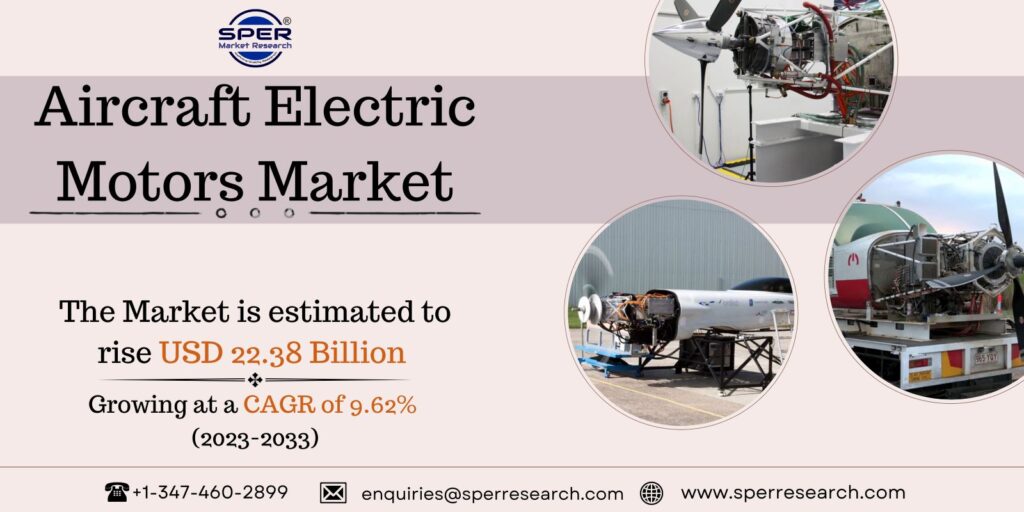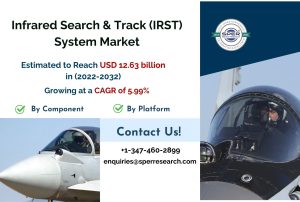Electric motors specifically made for use in aircraft systems, or “aircraft electric motors,” are used for a variety of purposes. They are essential in providing power and propulsion for various aircraft systems and components. These motors can be powered by various energy sources, depending on the particular aircraft and its needs. Electric batteries, which are becoming more sophisticated and are able to produce high-power outputs, could power them.
According to SPER market research, ‘Aircraft Electric Motors Market Size- By Type, By Output Power, By Torque, By Power Density, By Aircraft Type, By End Use, By Application – Regional Outlook, Competitive Strategies and Segment Forecast to 2033’state that the Aircraft Electric Motors Market is predicted to reach USD 22.38 billion by 2033 with a CAGR of 9.62%.
Several factors support the growth and development of the global aircraft electric motors market. The first major driver has been the demand for cleaner and more effective aircraft systems is being driven by escalating environmental regulations and a growing emphasis on reducing emissions in the aviation sector. When compared to conventional combustion engines, aircraft electric motors have lower emissions and better fuel efficiency, making them a good option for stakeholders who care about the environment.
Additionally, electric motors may result in cost savings. The operational costs, such as fuel and maintenance, may be significantly lower than with traditional engines, despite the higher initial investment. The cost advantage is alluring to manufacturers, operators, and fleet owners of aircraft.
There are a variety of challenges that the market for aircraft electric motors must overcome in order to develop and grow. The limited energy density and capacity of current battery technologies are one of the main issues. High-capacity batteries are necessary for electric aircraft to have enough power for propulsion, but current battery technology might not be able to handle the demands of larger aircraft or long-distance flights. To overcome this obstacle and allow the use of electric motors in a wider variety of aircraft applications, advancements in battery technology are required. The infrastructure needed to support electric aviation presents another difficulty. Airports and other locations currently lack the infrastructure needed to charge or refuel electric aircraft. To ensure the wide adoption of electric motors in aircraft, building a strong infrastructure network for electric aviation presents logistical and financial challenges that must be addressed.
Request For Free Sample Report @ https://www.sperresearch.com/report-store/aircraft-electric-motors-market.aspx?sample=1
The COVID-19 pandemic has had a significant impact on the Global Aircraft Electric Motors Market resulting in reduced capital expenditure and a focus on cost-saving measures. As a result, there have been fewer investments made in modernising and upgrading aircraft, which has had an effect on the demand for aircraft electric motors. The outbreak has severely reduced demand for air travel and reduced aircraft production in the aviation sector. The demand for aircraft electric motors has been impacted as a result of the decreased need for new aircraft and the retrofitting of existing aircraft.
Globally, there is a demand for Aircraft Electric Motors in a number of nations and regions, including Asia-Pacific, Europe, Middle East and Africa, North America, Latin America. Additionally, some of the market key players are; Altra Industrial Motion Corporation (US), Meggitt PLC (UK), Moog Inc. (US), Rolls-Royce PLC (UK), Woodward, Inc. (US).
Aircraft Electric Motors Market Segmentation:
The SPER Market Research report seeks to give market dynamics, demand, and supply forecasts for the years up to 2033. This report contains statistics on product type segment growth estimates and forecasts.
By Type: Based on the Type, Global Aircraft Electric Motors Market is segmented as; AC Motors, DC Motors.
By Output Power: Based on the Output Power, Global Aircraft Electric Motors Market is segmented as; 10-200KW, above 200KW, Up to 10KW, Other.
By Torque: Based on the Torque, Global Aircraft Electric Motors Market is segmented as; 1-50Nm, 50-200Nm, above 200Nm, Up to 1Nm, others.
By Power Density: Based on the Power Density, Global Aircraft Electric Motors Market is segmented as; 5–10 kW/kg, Above 10 kW/kg, Up to 5 kW/kg, Others.
By Aircraft Type: Based on the Aircraft Type, Global Aircraft Electric Motors Market is segmented as; Advanced Air Mobility, Fixed Wing, Rotary Wing, Unmanned Aerial Vehicles, Others
By End Use: Based on the End Use, Global Aircraft Electric Motors Market is segmented as; Aftermarket, OEM, Others
By Application: Based on the Application, Global Aircraft Electric Motors Market is segmented as; Avionics Systems, Cabin Interior Systems, Door Actuation Systems, Engine Control Systems, Environmental Control Systems, Flight Control Systems, Landing and Braking Systems, Propulsion Systems.
By Region: This report also provides the data for key regional segments ofAsia-Pacific, Europe, Middle East and Africa, North America, Latin America.
This study also encompasses various drivers and restraining factors of this market for the forecast period. Various growth opportunities are also discussed in the report.
For More Information, refer to below link:-
Aircraft Electric Motors Market Future Outlook
Related Reports:
Follow Us –
LinkedIn | Instagram | Facebook | Twitter
Contact Us:
Sara Lopes, Business Consultant – U.S.A.
SPER Market Research
+1-347-460-2899



